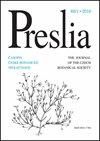Naturalized alien flora of the world: species diversity, taxonomic and phylogenetic patterns, geographic distribution and global hotspots of plant invasion
IF 4.4
2区 生物学
Q1 PLANT SCIENCES
引用次数: 349
Abstract
Using the recently built Global Naturalized Alien Flora (GloNAF) database, containing data on the distribution of naturalized alien plants in 483 mainland and 361 island regions of the world, we describe patterns in diversity and geographic distribution of naturalized and invasive plant species, taxonomic, phylogenetic and life-history structure of the global naturalized flora as well as levels of naturalization and their determinants. The mainland regions with the highest numbers of naturalized aliens are some Australian states (with New South Wales being the richest on this continent) and several North American regions (of which California with 1753 naturalized plant species represents the world’s richest region in terms of naturalized alien vascular plants). England, Japan, New Zealand and the Hawaiian archipelago harbour most naturalized plants among islands or island groups. These regions also form the main hotspots of the regional levels of naturalization, measured as the percentage of naturalized aliens in the total flora of the region. Such hotspots of relative naturalized species richness appear on both the western and eastern coasts of North America, in north-western Europe, South Africa, south-eastern Australia, New Zealand, and India. High levels of island invasions by naturalized plants are concentrated in the Pacific, but also occur on individual islands across all oceans. The numbers of naturalized species are closely correlated with those of native species, with a stronger correlation and steeper increase for islands than mainland regions, indicating a greater vulnerability of islands to invasion by species that become successfully naturalized. South Africa, India, California, Cuba, Florida, Queensland and Japan have the highest numbers of invasive species. Regions in temperate and tropical zonobiomes harbour in total 9036 and 6774 naturalized species, respectively, followed by 3280 species naturalized in the Mediterranean zonobiome, 3057 in the subtropical zonobiome and 321 in the Arctic. The New World is richer in naturalized alien plants, with 9905 species compared to 7923 recorded in the Old World. While isolation is the key factor driving the level of naturalization on islands, zonobiomes differing in climatic regimes, and socioeconomy represented by per capita GDP, are central for mainland regions. The 11 most widely distributed species each occur in regions covering about one third of the globe or more in terms of the number of regions where they are naturalized and at least 35% of the Earth’s land surface in terms of those regions’ areas, with the most widely distributed species Sonchus oleraceus occuring in 48% of the regions that cover 42% of the world area. Other widely distributed species are Ricinus communis, Oxalis corniculata, Portulaca oleracea, Eleusine indica, Chenopodium album, Capsella bursa-pastoris, Stellaria media, Bidens pilosa, Datura stramonium and Echinochloa crus-galli. Using the occurrence as invasive rather than only naturalized yields a different ranking, with Lantana camara (120 regions out of 349 for which data on invasive status are known), Calotropis procera (118), Eichhornia crassipes (113), Sonchus oleraceus (108) and Leucaena leucocephala (103) on top. As to the life-history spectra, islands harbour more naturalized woody species (34.4%) thanmainland regions (29.5%), and fewer annual herbs (18.7% compared to 22.3%). Ranking families by their absolute numbers of naturalized species reveals that Compositae (1343 species), Poaceae (1267) and Leguminosae (1189) contribute most to the global naturalized alien flora. Some families are disproportionally represented by naturalized aliens on islands (Arecaceae, Araceae, Acanthaceae, Amaryllidaceae, Asparagaceae, Convolvulaceae, Rubiaceae, Malvaceae), and much fewer so on mainland (e.g. Brassicaceae, Caryophyllaceae, Boraginaceae). Relating the numbers of naturalized species in a family to its total global richness shows that some of the large species-rich families are over-represented among naturalized aliens (e.g. Poaceae, Leguminosae, Rosaceae, Amaranthaceae, Pinaceae), some under-represented (e.g. Euphorbiaceae, Rubiaceae), whereas the one richest in naturalized species, Compositae, reaches a value expected from its global species richness. Significant phylogenetic signal indicates that families with an increased potential of their species to naturalize are not distributed randomly on the evolutionary tree. Solanum (112 species), Euphorbia (108) and Carex (106) are the genera richest in terms of naturalized species; over-represented on islands are Cotoneaster, Juncus, Eucalyptus, Salix, Hypericum, Geranium and Persicaria, while those relatively richer in naturalized species on the mainland are Atriplex, Opuntia, Oenothera, Artemisia, Vicia, Galium and Rosa. The data presented in this paper also point to where information is lacking and set priorities for future data collection. The GloNAF database has potential for designing concerted action to fill such data gaps, and provide a basis for allocating resources most efficiently towards better understanding and management of plant invasions worldwide.世界归化外来植物群:物种多样性、分类和系统发育格局、植物入侵的地理分布和全球热点
利用新近建立的全球外来归化植物区系(GloNAF)数据库,对全球483个大陆和361个岛屿地区的外来归化植物区系的分布数据进行了分析,揭示了全球外来归化植物区系的多样性和地理分布格局,以及全球外来归化植物区系的分类、系统发育和生活史结构、归化水平及其决定因素。归化外来物种数量最多的大陆地区是澳大利亚的一些州(新南威尔士州是该大陆上最丰富的州)和北美的几个地区(其中加利福尼亚有1753种归化植物,是世界上归化外来维管植物最丰富的地区)。英国、日本、新西兰和夏威夷群岛在岛屿或岛群中拥有大多数归化植物。这些地区也形成了区域归化水平的主要热点,以归化的外来物种占该地区总植物区系的百分比来衡量。这种物种丰富度相对归化的热点地区出现在北美的东西海岸、欧洲西北部、南非、澳大利亚东南部、新西兰和印度。归化植物入侵岛屿的高水平集中在太平洋,但也发生在所有海洋的个别岛屿上。归化物种数量与本土物种数量密切相关,岛屿比大陆地区的相关性更强,增加幅度更大,表明岛屿更容易受到成功归化物种的入侵。南非、印度、加利福尼亚、古巴、佛罗里达、昆士兰和日本的入侵物种数量最多。温带和热带区分别有9036种和6774种归化物种,其次是地中海区3280种、亚热带区3057种和北极区321种。新世界有更丰富的外来归化植物,有9905种,而旧大陆有7923种。虽然孤立是推动岛屿入籍水平的关键因素,但气候制度和以人均国内生产总值为代表的社会经济不同的生物区系是大陆地区的核心因素。11种分布最广的物种分别出现在大约覆盖全球三分之一或更多的地区,就其归化的地区数量而言,这些地区的面积至少占地球陆地面积的35%,其中分布最广的物种Sonchus oleraceus出现在覆盖42%的世界面积的48%的地区。其他广泛分布的物种有蓖麻、牛角草、马齿苋、印度莲、Chenopodium album、Capsella bursa-pastoris、Stellaria media、Bidens pilosa、曼陀罗和Echinochloa crucgalli。如果将其作为入侵物种而非仅仅归化物种,则会得出不同的排名,其中大绒猴(Lantana camara)(在349个已知入侵状态数据的地区中,有120个)、Calotropis procera(118)、Eichhornia crassipes(113)、Sonchus oleraceus(108)和Leucaena leucocephala(103)位居榜首。在生活史光谱上,海岛的归化木本物种(34.4%)多于大陆(29.5%),一年生草本物种(18.7%)少于大陆(22.3%)。归化物种的绝对数量排序显示,全球归化外来植物区系中,菊科(1343种)、禾本科(1267种)和豆科(1189种)贡献最多。一些科在岛屿上有不成比例的外来归化代表(槟榔科、天南星科、棘科、Amaryllidaceae、天门冬科、旋花科、茜草科、锦葵科),而在大陆上则少得多(芸苔科、石竹科、菖蒲科)。将一个科的归化物种数量与其全球物种丰富度进行比较,可以发现在归化的外来物种中,一些物种丰富的大科(如豆科、豆科、玫瑰科、苋科、松科)被过度代表,而一些物种代表性不足(如Euphorbiaceae、Rubiaceae),而归化物种最丰富的科(菊科)达到了其全球物种丰富度的预期值。重要的系统发育信号表明,其物种归化潜力增加的科在进化树上不是随机分布的。归化种数最多的属是茄属(112种)、大胡属(108种)和苔属(106种);岛上主要有Cotoneaster、Juncus、Eucalyptus、Salix、Hypericum、Geranium和Persicaria,而大陆上相对丰富的归化物种有Atriplex、Opuntia、Oenothera、Artemisia、Vicia、Galium和Rosa。本文中提供的数据还指出了缺乏信息的地方,并确定了未来数据收集的优先事项。 GloNAF数据库有潜力设计协调一致的行动来填补这些数据空白,并为最有效地分配资源提供基础,以更好地了解和管理世界范围内的植物入侵。
本文章由计算机程序翻译,如有差异,请以英文原文为准。
求助全文
约1分钟内获得全文
求助全文
来源期刊

Preslia
生物-植物科学
CiteScore
5.20
自引率
29.40%
发文量
8
审稿时长
>12 weeks
期刊介绍:
Preslia is a peer-reviewed scientific journal publishing original research papers on plant systematics, morphology, phytogeography, ecology and vegetation science, with a geographical focus on central Europe. The journal was founded in 1914 and named in honour of brothers Jan Svatopluk Presl (1791–1849) and Karel Bořivoj Presl (1794–1852), outstanding Bohemian botanists. It is published quarterly by the Czech Botanical Society.
 求助内容:
求助内容: 应助结果提醒方式:
应助结果提醒方式:


